Thermal fingerprinting: a way to optimize lyophilization
Pharmaceutical Technology Europe
Freeze drying is widely used in pharmaceuticals to improve the long-term storage stability of labile drugs.
Freeze drying is widely used in pharmaceuticals to improve the long-term storage stability of labile drugs. Most new biotechnology products require a stabilising process (often lyophilisation) where developers use scientific techniques that define the correct parameters for new processes.1
Because of the great number of biotechnological products used during the last 20 years, several techniques have been developed to increase knowledge into the lyophilisation process. Stabilisers used in biotechnology products (for the most part proteins) generate formulations difficult for freeze drying.2
Often, the use of cryo- and lioprotectors involves using polyols, such as sugars; specific examples being sucrose, maltose, lactose, trehalose and sorbitol. The amorphous behaviour of these sugars (the low glass transition temperature [Tg'] of sorbitol is well known) tends to promote the collapse of the cake. This necessitates a greater knowledge of thermal properties of the product once the suitable formulation is developed.
Knowledge derived from these studies is generally applied to new products, but the lyophilisation processes of a large number of well-known products — mainly generic and old formulations — are purely historical. This gives rise to long cycles that tend to be unreliable because of poor initial process development.
Detailed study and/or revision of these established formulations that results in process/cycle improvement would be extremely beneficial. 'Thermal fingerprinting' could not only provide shortened cycles (thus improving cost), but the revised process would be entirely appropriate to the product being processed. This, in turn, would optimise residual moisture, appearance, reconstitution time and potency.
Inaccurate cycles can induce microcollapse and microconcentrations, which can lead to an eventual reduction of product stability. The development process applied to established and generic product cycles will be much simpler than those that apply to biotech products; however, surprises may be evident, caused by the specification change at the time-release because of the evolution of pharmacopoeias. The data written in the laboratory log files permit easy detection of out-of-date specifications when a new registration of a generic drug is done.
A simple way to optimise the process
We have developed a simple system that has been shown to shorten and rationalise the lyophilisation process. The procedure consists of establishing the thermal fingerprint (TF), which characterises the thermal behaviour of the formulation of a well-known antibiotic macrolide. The use of techniques such as differential scanning calorimetry (DSC) and freeze dryer microscope (FDM) permit the determination of the critical product input temperatures required for the freeze-drying process: total solidification temperature (Tts), Tg' and collapse temperature (Tco).
The development procedure begins based on the current process/cycle that we seek to shorten. In this initial process, bottom breakage was observed. Inputs such as shelf temperature and chamber pressure during the different steps of the process (freezing, primary and secondary drying) are tested and initially developed in a pilot plant before being scaled up to the industrial plant when appropriate. The final product specifications of the new cycle are compared with those obtained in the original cycle.
The lyophilisation recipe has to be based on the structural characteristics of the product and on its thermal behaviour when subjected to freezing and drying processes.3
The physical models of the freeze-drying process are based on the thermal behaviour of the defined formulation; that behaviour is supported by the thermodynamic laws that governed it. Thermal behaviour is defined by studies that allow us to determine temperature values, but temperature is an intensive magnitude and we cannot use it to quantify and control the heat and mass transfer. Therefore, we must find the quantified results by implementing these laws (Ohms' Law: 'Law applied to fluid dynamics'; Newton's Law of cooling; Clausius-Clapeyron relationship: thermodynamics of open systems and so one). These models, as well as those based on mathematical or statistical methods, can add a high level of complexity to the resolution of the problem. A simpler approach, however, can be made based on knowledge such as the TF. The TF only attempts to reduce up to five or six intensive magnitudes of the product's thermal behaviour.
In essence, the TF (Figure 1) encompasses the five critical temperatures that characterise the formulation in specific way: freezing temperature (Tts); melting temperature (Tm); eutectic temperature (just for crystalline products); Tg'; and Tco.
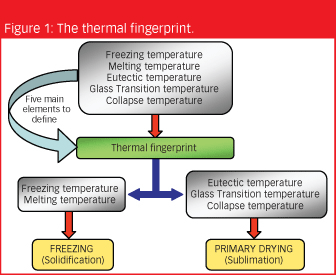
Figure 1: The thermal fingerprint.
These five temperatures are crucial elements that define the TF of the formulation. They are divided into two groups; one group sets the freezing process, whilst the second group sets the primary drying process. 'Solidification' depends on the freezing and melting temperatures, whereas 'sublimation' is affected by the eutectic, glass and collapse temperatures.
Materials and methods
We have established TF using the following elements:
- 500 mg of API per unit.
- 12.5 mL dose of solution per vial.
- No sugar‑type excipients.
- 6.2% solid material content; height of the solution inside the vial is 23 mm.
- Moisture content specification is not more than 3% and the maximum temperature allowed by the product is 35 °C.
- The solution is filled in a tubular glass type, 20‑mL vial.
The TF of the product has been determined by means of DSC and FDM. The pilot tests have been developed in a pilot plant Lyobeta (Telstar SA, Spain).
Differential scanning calorimeter (DSC)
The DSC821 calorimeter (Perkin Elmer, MA, USA) was used to obtain the Tts, the Tm and the Tg’. The sample (20 µL) is placed in an aluminium sump. The system freezes the samples (problem and reference) down to -100 °C, at a rate of 10 °C/min, then heats the samples up to 25 °C.
Freeze-dryer microscope (FDM)
The Olympus Microscope with the Olympus U-TV0.5XC-3 camera (Japan) is used to obtain the Tm and the Tco. The sample (2 µL) is placed on the Linkam support. The system freezes the sample to -50 °C and then heats it at a rate of 10 °C/min under vacuum conditions (0.100 mbar). The process is recorded and pictures can be seen in the SCADA system.
Freeze-dryer pilot plant
The equipment that we use has the following features:
- Two shelves of 0.04 m2 of surface. The condenser has a recovery capacity of 3 kg of ice.
- Temperature probes are placed in the shelves and inside the thermoregulator system, which controls the process. There are also probes for the product. All temperature probes are Pt100 type. The minimum temperature reached in the chamber is -50 °C, while in the condenser the minimum temperature is -65 °C.
- The flow of the vacuum pump is 9 m3/h.
- The vacuum is measured by two types of gauge: pirani and Baratron (capacitative). When the differences between both measurements are at the minimum, the end point of the primary drying has been reached.
- The diameter of the main valve is 100 mm.
Results: the original cycle
The original cycle consisted of 12 h of slow freezing at -50 °C (with a decrease of approximately 6 °C/h). The primary drying process was divided into two stages: the first one, where shelf temperature was -10 °C and the second one, where shelf temperature was +35 °C. Chamber pressure was about 330 mbar (33 Pa) during both stages of the primary drying process. Finally, the secondary drying process, working at a shelf temperature of +35 °C, took 15 h, reaching a chamber pressure of 24 mbar (2.4 Pa).

Figure 2: Graph of the original cycle.
The results were as follows:
- moisture content: 0.5%
- total process time: 87 h
- end point: P ≈ 2.4E-02 mbar
- problem: bottom breakage (5%)
- reconstitution time: < 1.5 min.
With this cycle, reconstitution time was acceptable (< 1.5 min), moisture content was within specifications and the whole process took 87 h. Apart from facing a long cycle, the main concern was that 5% of the vials showed bottom breakage because of an excessive pressure inside the vial during the primary drying process. Figure 2 and Table 1 show the graph and parameters of the cycle.

Table 1: Set up in the freeze dryer - original cycle.
Results: Thermal fingeprint
DSC analysis
Graphs of the DSC technique are shown in Figure 3 and Figure 4. Figure 3 shows the Tts. The curve shows an endothermic process during the cooling of the sample; the process moves from right to left (on the graph) and the state change finishes at the endset or beyond, if we’re looking for the stabilisation.
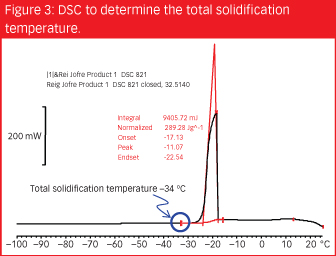
Figure 3: DSC to determine the total solidification temperature.
Figure 4 shows the Tm and Tg’. In both cases, the fraction of the curve corresponds to the warming of the sample; the process moves from left to right and involves endothermic processes. The inflection points mark the onset of the melting and the glass transition temperatures, respectively. Here we find two glass transitions, but only the second one produces collapse.

Figure 4: DSC to determine the glass transition and melting temperatures.
FDM analysis
Figure 5 shows pictures of a formulation drop in different stages of the process (FDM). This product suffered from a collapse effect not noticeable visually because of the high solid material content that kept the cake shape. The complete blockage of the channels inside the matrix caused a high pressure at the bottom of the vial and was responsible for the breakage. After confirming the collapse effect at the FDM, annealing treatment was decided to be applied during the freezing process to avoid collapse.
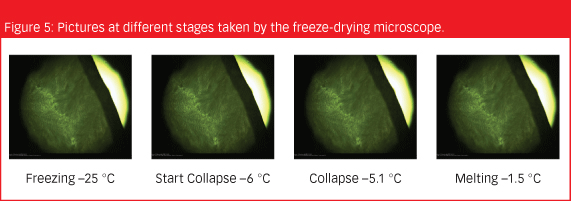
Figure 5: Pictures at different stages taken by the freeze-drying microscope.
Scale up
Considering the data provided by the TF (Tm -1.5 °C and Tts -34 °C), the following parameters for the annealing treatment were set: freezing the product down to -40 °C, then heating it to -7 °C (without reaching the Tm) and finally, freezing it again down to the Tts. The timing for this process was 6, 4 and 3 h, respectively, having a total process time of 13 h in the industrial plant.
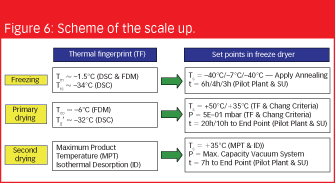
Figure 6: Scheme of the scale up.
During primary drying, the product was tested under forced conditions: high shelf temperature4,5 and chamber pressure. Sublimation operated correctly, but in order not to exceed the maximum temperature according to stability studies, the temperature was lowered accordingly in a second step. Set points in the pilot plant were the following: shelf temperature: +50 °C and +35 °C, chamber pressure: 500 µbars (50 Pa) until reaching the end point; 30 h of total process time in the industrial plant. During secondary drying, shelf temperature was set at the maximum temperature allowed by the product: +35 °C, chamber pressure was set to the minimum value provided by the equipment vacuum system; the necessary time for completing the process in the industrial plant was 7 h. Figure 6 shows the scheme of the scale up:
Final cycle
The application of this new cycle kept the final product features within specifications (moisture content and reconstitution time).
- moisture content: <0.5%
- total process time: 50 h
- end point: P ≈4E-02 mbar
- no bottom breakage
- reconstitution time: < 1.5 min.
Importantly, we solved the breakage problem4,5 with this process. In addition, the cycle was successfully optimised with a reduction in total process time of 37 h (43% reduction — original cycle: 87 h; new: 50 h) when compared with the original cycle. Figure 7 shows the cycle graph.

Figure 7: Graph of the final cycle.
Conclusion
Applying the TF concept can provide a basis to establish a consistently reliable freeze drying protocol. Some equipment manufacturers and other investigators are developing systems to define a scientific model for the process; however, in practice, it is difficult to find these. The above cycle optimisation process illustrates that at least the temperature and pressure limits of the process can be determined by means of this concept. Obviously, the TF cannot quantify the mass flow or the energy transfer, but it can considerably reduce the time required to develop the process by avoiding the traditional trial and error approach.
Enric Jo is Plant Manager at Reig Jofre (Spain)
References
1. M.J. Pikal, “Lyophilization”, in M. Dekker (Ed) Encyclopedia of Pharmaceutical Technology (Marcel Dekker, 2001) pp 1299-1326.
2. J.F. Carpenter et al., Pharm Res., 14, 969-975 (1997).
3. X.C.M. Tang, S.L. Nail and M.J. Pikal, PharmSciTech, 7(4) Article 93 (2006).
4. B.S. Chang and N.L. Fischer, Pharmaceut. Res., 12(6), 831-837 (1995).
5. F. Fonseca et al., Impact of physical properties of bioproducts on formulation and on freeze-drying cycle development (Vienna Congress ISPE, September 2006).
6. G. Jiang et al., PDA J. Pharmaceut. Sci. Tech., 61(6) 441-51 (2007).
7. G. Jiang et al., PDA J. Pharmaceut. Sci. Tech., 61(6) 452-60 (2007).
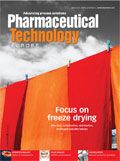
Drug Solutions Podcast: A Closer Look at mRNA in Oncology and Vaccines
April 30th 2024In this episode fo the Drug Solutions Podcast, etherna’s vice-president of Technology and Innovation, Stefaan De Koker, discusses the merits and challenges of using mRNA as the foundation for therapeutics in oncology as well as for vaccines.